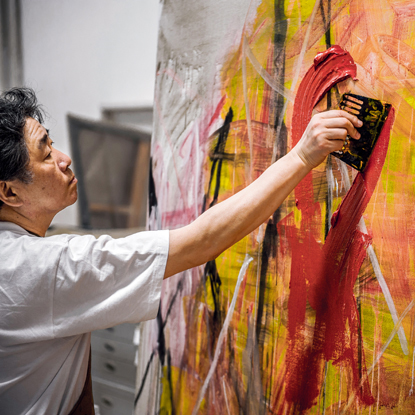谭平自述
我认为一件好的艺术作品,作品自身的质量只是评价它的一个最基本的方面,作品未来将要展示的空间是作品最终完成的完整体现。艺术家在创作的时候是否考虑“空间”因素,如何确立作品与“空间”的关系,这些思考是决定最后创作出的作品能否呈现一个完整形态的关键。
在中国美术馆中厅做展览,对一个中国艺术家来讲,是一生当中很重要的事情,每个人都会将自己积攒的力量掷入这个空间,选择自己最重要的作品在中厅呈现成为一件毋庸置疑的事。我有幸成为第一个在美术馆中厅举办个展的中国抽象艺术家,那么此时此刻,对我自己和对美术馆来讲,举办这样的展览,意义到底在哪里?展出以往已经完成的作品还是为此空间去创作?当然是后者。为此我不断地去展厅看场地,想象一件什么样的抽象作品能够和将近40米的圆弧墙面,带着权威感的空间形态对话,如何打破我们对经典展厅的固有认识,如何让一个抽象展览、一件抽象作品成为一次对观者和空间的双重挑战,如何赋予这个传统空间以新的意义?那么抛弃放置传统的、大型的、带有经典画框装裱的平面绘画作品的想法是我第一件要做的事。
创作一件能和这个40米的弧面空间共振的作品,其作品需要聚集足够的张力和强度,才能占据这个空间。开始的时候我设想以尺度宏大和强烈的多媒体形式来制造另一种氛围,而当我试着寻找内心最初的冲动,追溯艺术的本源的时候,弧型空间静谧下来,一条细细的曲线横贯弧形墙面。
我们是从一个圆开始认识世界。就像第一次拿起画笔的小孩,画一个人就是一个圆形,随着年龄的增长,他会在大圆上面画出小圆,画出人的胳膊和腿。上小学的时候,内心的破坏欲蠢蠢欲动,一颗不安分的种子拒绝接受一切被框住的理想,上课的铃声是放学的前奏,课本上的涂鸦挥霍着青春期的狂想。放学路上狂奔的手里拿着不知道从哪里捡来的小木棍一路涂划,从一个胡同飞奔到另一个胡同,手里的棍子飞速地划过这面墙,断开,再到下一面墙,接上,留下弯弯曲曲的痕迹仿佛是青春破坏的足迹。十二三岁的年纪给我最强的感受就是这样的破坏欲,一种无拘无束的状态。那么今天,在美术馆,在这么长的一面墙上,我应该找回那样的状态吗?还是用一根40米的长线以顽童的心态完成一次精神旅程的远足?
这是一个激动人心的灵感,开始的时候,我设想采用大尺度多媒体语言制造一个幻觉的空间,最后的决定却是采用艺术语言中最为简单和原始的木刻版画方式表达我的灵感。一把圆口刻刀与一块长长的木板,如同决斗的双方,静静地等待开始的口令。一把刻刀在40米长的木板行走需要非常复杂的准备工作,从对刻刀种类的选择,到刀的尺度与我身体的尺度相协调;木板材质则要求这种板要刀刻下去既能游刃有余,刀刻留下的痕迹还要稍微有点稚拙。40米长的一条线,用了6个小时一气呵成。刻刀与木板接触的瞬间如同锋利的刀划开皮肤,深深地,慢慢地行走,不断深入这块黑色平面的内部。六个小时刻刀在木板上抑扬顿挫地行走就像将我自己沉入生命的“时刻”,所有的力量,所有的经历,对艺术的理解,包括我内心的挣扎,全部留在刀和木板磕绊的瞬间,只有这样才能表达我追求的精神境界。但是在深灰色表面上,只留下一根白色曲线。六个小时在此时尤为变得漫长,刻刀一米一米地前行,断断续续,一切都令人窒息。在工作的时刻,我并不会想“人生”那么大的主题,线条的节奏与美感,也不会想我表达某一个悲伤的时刻,或者某一天的快乐,只是去感受刻刀刻进木板里的阻顿与游刃,发出的咔咔的声音。我既要观察这根线的走向与变化,又不能思考过多,如同人在走路的时候并不会意识到自己正在走路,是伴随着生命运动的状态。刻刀在我的手里在接触木板的一瞬间成为我精神的出口,跟随着我的生命移动,呈现我对艺术与人生的认识。
I believe, for a good piece of art, its internal quality makes up for just one aspect of its evaluation, it is in the exhibition space that the artwork and its value come into full realization. Has the artist taken into consideration the 'spatial' elements during the creative process? How does he define the relation between the artwork and the 'space' it is set in? These questions ultimately determine whether a piece of art is fulfilled in its entirety.
For any Chinese artists, to have an exhibition in the Main Hall of the National Art Museum of China (NAMOC) is a lifetime event. No doubt one would throw in all one's energy into the space and carefully select one's seminal works to be put in the Hall. I, having the honor to be the first Chinese abstract artist to carry out a solo exhibition in the Main Hall, have thought about what it means, both for me and for the Museum, to have such an exhibition. Whether to show works in the past, or to create afresh for this particular space? The answer is, as it turned out, the latter. For this purpose, I've made numerous field trips to the museum and have been trying to conceive what kind of an abstract work would strike up a conversation with the nearly 40 meter long, curved space that seemingly carries an authoritative air. How to upset people's preconception about the classical exhibition space? How to make an abstract exhibition, an abstract artwork a double challenge to both the audience and the space? How to assign new meanings to the conventional museum space? The first thought that came to me is that I am going to discard the established, large-scaled, framed, two-dimensional canvas.
For an artwork to resonate with the 40 meter curved space, it has to summon enough strength and tension to occupy that space. At the very beginning, I considered using impactful scale and multimedia displays to create a strong presence, but when I started tracing the very first, innermost impulse, and the very origin of my creation, the Hall began to quiet down and a long, thin, curved line surfaced the wall.
We begin our understanding of the world from a circle. When a boy first picks up a drawing pen, the first human figure he draws is a circle. As he grows, he adds small circles to the big one, to create arms and legs. I remember how, as a school child, I was constantly stirred by an urge to "destroy". The seed of unrest within me was always ready to resist any form of confinement. The school bell preluded the after-class hours, and the mindless doodling on textbooks composed a childhood rhapsody. Roaming the streets, I picked up a small wooden stick from nowhere, then fled from one Hutong to another, scratching the Hutong walls with the stick in my hand. It thrust through a wall, stopped, then another wall, and another, leaving long, curvy lines that mark my youthful destruction. My most vivid memory of that age, 12 or 13, was the desire to 'destroy', and its carefree state. Today, as I am standing at the Hall of the Museum, facing this long wall, should I return to that state-of-the-past? Would I fulfill a spiritual excursion with this 40 meter long line, once again in that mental state of the unsettled youth?
It is an inspirational moment, starting from projecting an illusionistic space with big scale and multimedia presentation, to eventually settling down on wood-cutting, one of the most basic techniques in print-making, primitive even. Now a rounded knife and a long, wooden panel, like rivals in a dual, wait in quiet for the call to charge. To work a knife on a 40 meter long panel requires complicated preparations: from choosing the right knife, to tuning the scale of the knife to that of my body; the wooden surface demands both the dexterity of the knife but also a certain level of crudity of the marks it leaves. The 40 meter long line was done with a single, continuous breath within six hours. The moment the knife touches the panel is like that of a sharp blazer cutting through the skin, marching slowly and ever deeply into the dark surface. Six hours of undulating movement submerges me entirely into the ‘moment’ of my life, as if all my energy, experience, knowledge, and my internal struggles, all are sealed within the pivotal moment the knife collides with the panel. Only in this way can I envisage the spiritual territory that I have aspired to, even though all that is left is a curvy, white trace on a dark surface. The six hours seem infinitely prolonged with the knife marching inch by inch, almost creating suffocation as a result of the intense focus. While I am working, serious reflections on “life” scarcely enter me. The beauty and rhythm of the line does not recall any particular moment of sadness, or gaiety. I am only feeling intensely the advancement of the knife and the resistance it has met, while a cracking sound is made. I have to keep an eye on the direction and shift of the knife, and yet not think too much, as a walking person wouldn’t be conscious of his walking. The instant I set my knife on the wooden panel it becomes a spiritual release, revealing my view on art and life, as it moves in spontaneous with the tempo of my life.
